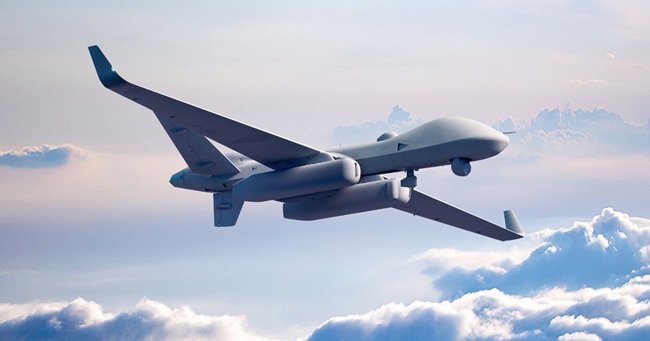
After announcing their teaming up earlier this year, GA-ASI and Saab have now announced an ambitious target to conduct flight operations with their AEW (Airborne Early Warning) solution for the MQ-9B already in the summer of 2026. The trials will be carried out at GA-ASI’s Desert Horizon flight operations facility in Southern California.
The MQ-9B is a medium altitude, long endurance (MALE) drone that can fly for over 30 hours, depending on missions and configurations, so it represents a good solution for persisted airborne early warning and target tracking.
Saab brings to the table the experience gathered in years of work on AEW radars for manned aircraft through the ERIEYE radar-mission system line which has culminated, at present, in the GLOBAL EYE solution based on the Bombardier Global 6000 business jet.
Saab will supply an AESA solution in pods, with antennas featuring transceiver modules made with GaN (gallium nitride) semi-conductors. The 2 AESA arrays, one per side, will be accommodated within special pods (developed by GA-ASI) to be carried under the wings, while a third pod, containing the common avionics for the entire AEW system, will be installed on the centreline pylon. It is anticipated that a MQ-9B AEW will be able to fly surveillance missions of up to 20 hours, still a very noticeable mission endurance.
The solution will be used stand-alone or in crewed-uncrewed teaming. GA-ASI has been pushing the idea for some time, notably presenting the concept also to the NATO AEW Force as part of the quest for a capability that can entirely replace the aging and increasingly obsolescent fleet of E-3 SENTRY aircraft.
With the recent announcement by NATO that plans for procurement of 6 E-7 WEDGETAIL have been terminated, Saab is targeting the NATO opportunity with the already mentioned GLOBAL EYE, on order for Sweden and which is also expected to be acquired by France. Being able to offer a solution based on the MQ-9B would give Saab another shot at the coveted NATO requirement.
Crucially, the podded AEW solution is also intended to be entirely compatible with the MQ-9B Short Take Off and Landing (STOL) wing-kit that GA-ASI is testing in the wing tunnel to enable the drone to operate from aircraft carriers without need for catapults and arresting wires.
The Royal Navy is particularly interested in this solution as a replacement for the current CROWSNEST kit carried currently on AW-101 MERLIN helicopters. A formal RFI has already been issued, with a sizeable budget notionally over 1 billion pounds in the long term. The Royal Navy hopes to replace CROWSNEST relatively soon (2029 – 2030) and has won significant backing from the recently published Strategic Defence Review in its ambitions to bring uncrewed platforms on the carriers to realize the “first AEW air wing in Europe”.
Saab says work on the radar antennas in the laboratories is already ongoing. The flights trials in summer 2026 are already planned to include the participation of interested potential customers. The team believes that, if orders were to be placed within 2026, delivery could follow already in 2029.








.png)
